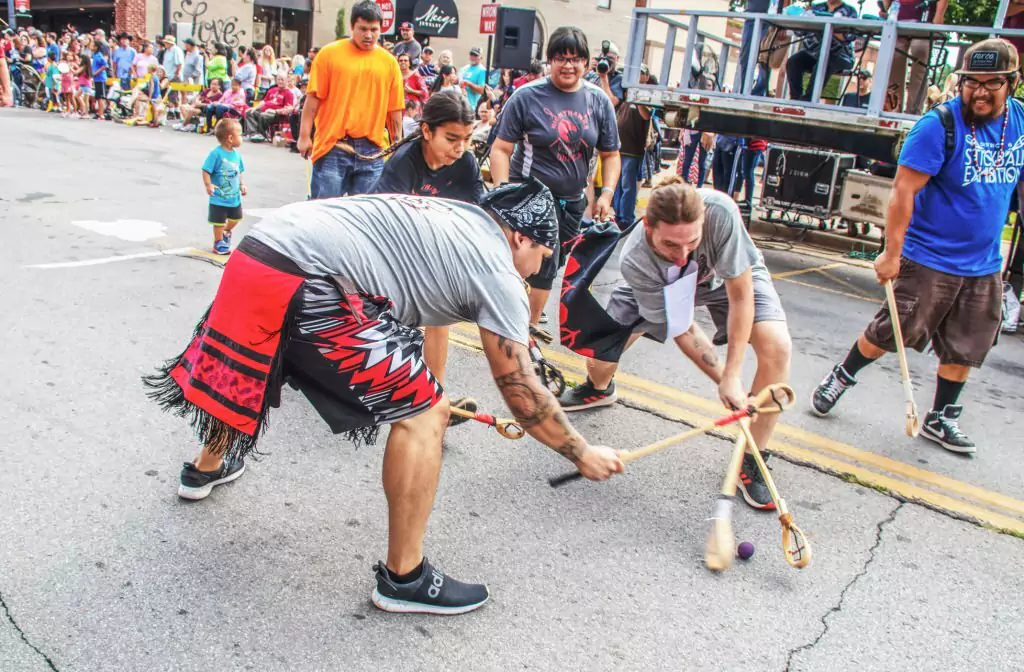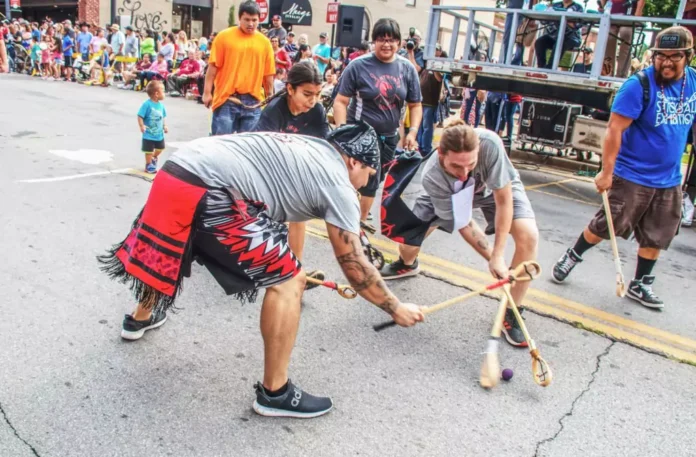Introduction
Stickball is a traditional Indigenous North American game that holds deep cultural and spiritual significance. Played by various Indigenous communities across the continent, stickball has been passed down through generations as a way to connect with ancestral traditions and promote community bonding.

This article will explore the history of stickball, its evolution in modern times, its role in Indigenous North American communities today, its importance as a cultural tradition, the health benefits it offers, the significance of stickball tournaments, the future of the game, its connection to social justice, and its global impact. By delving into these aspects, we can gain a deeper understanding of the rich heritage and enduring legacy of stickball.
The History of Stickball: A Game with Deep Roots in Indigenous North American Culture
The origins of stickball can be traced back thousands of years to Indigenous North American communities. The game was played by various tribes and nations, each with their own unique rules and variations. In some communities, stickball was seen as a way to settle disputes or honor spiritual beliefs. The game was often played on large fields or open spaces, with teams consisting of dozens or even hundreds of players.
Traditional stickball had strict rules and gameplay. The objective was to score points by hitting a ball into a designated area or goal using long sticks with nets attached to them. Players would use their sticks to catch, carry, and throw the ball, showcasing their agility and skill. The game was physically demanding and required teamwork and strategy.
Stickball held great significance in Indigenous North American culture and spirituality. It was not just a game but a way to connect with ancestors and the natural world. Many tribes believed that stickball had healing powers and could bring balance to individuals and communities. The game was often accompanied by ceremonies, songs, and dances that honored the spirits and sought their guidance.
The Evolution of Stickball: How the Game Has Adapted to Modern Times
Over time, stickball has evolved to adapt to modern times. Changes in equipment and rules have been made to accommodate different playing environments and promote safety. Traditional wooden sticks have been replaced with lighter and more durable materials, such as aluminum or synthetic materials. The size and weight of the ball have also been modified to suit different age groups and skill levels.
Incorporation of modern technology and media has also played a role in the evolution of stickball. Tournaments are now often live-streamed or televised, allowing a wider audience to witness the game. Social media platforms have provided a platform for players and communities to share their experiences and connect with others who share their passion for stickball.
However, the impact of colonization and assimilation cannot be ignored when discussing the evolution of stickball. The forced removal of Indigenous peoples from their ancestral lands, the suppression of cultural practices, and the introduction of Western sports have all had an impact on the traditional game. Despite these challenges, many Indigenous communities have worked tirelessly to preserve and revitalize stickball as a way to reclaim their cultural heritage.
The Role of Stickball in Indigenous North American Communities Today
Stickball continues to play a vital role in Indigenous North American communities today. It serves as a powerful tool for preserving cultural traditions and promoting community bonding. Through the game, Indigenous peoples can pass down ancestral knowledge, language, and values to future generations.
Stickball is not just a game; it is a way of life for many Indigenous North Americans. It fosters a sense of belonging and identity within communities, helping individuals connect with their roots and find pride in their heritage. The game brings people together, fostering social connections and promoting teamwork.
In addition to its cultural significance, stickball also serves as a form of resistance against ongoing marginalization and discrimination faced by Indigenous peoples. By reclaiming their traditional games and showcasing them to the world, Indigenous communities assert their sovereignty and challenge stereotypes. Stickball is a powerful symbol of resilience and strength.
Stickball as a Cultural Tradition: How Indigenous North Americans are Passing the Game Down to Future Generations
The intergenerational transmission of stickball traditions is crucial for its preservation. Indigenous North Americans recognize the importance of passing down the game to future generations as a way to ensure the continuity of their cultural heritage. Elders play a vital role in teaching young people the rules, techniques, and spiritual significance of stickball.
Stickball is not just about playing the game; it is also about learning the values and teachings embedded within it. Indigenous education systems often incorporate stickball as a way to teach young people about their history, language, and traditional knowledge. By engaging in stickball, young people develop a deeper understanding of their identity and their place within their community.
However, passing down stickball traditions is not without its challenges. The impact of colonization, urbanization, and modernization has led to the erosion of traditional knowledge and practices. Many Indigenous communities face difficulties in finding suitable spaces to play stickball or struggle with limited resources for equipment. Efforts are being made to address these challenges and create opportunities for young people to engage with stickball.
The Health Benefits of Stickball: How the Game Promotes Physical Fitness and Mental Wellness
Stickball offers numerous health benefits for those who engage in the game. From a physical standpoint, stickball provides an excellent cardiovascular workout, promoting heart health and endurance. The fast-paced nature of the game requires players to run, sprint, and change direction frequently, improving agility and overall fitness.
The game also offers strength training benefits as players use their sticks to catch, carry, and throw the ball. This helps build upper body strength and improves hand-eye coordination. Additionally, stickball requires teamwork and communication, fostering social connections and promoting mental wellness.
Engaging in stickball can also have positive effects on mental health. The physical activity involved in the game releases endorphins, which can improve mood and reduce stress. The game’s strategic nature requires players to think quickly and make split-second decisions, enhancing cognitive skills and mental agility.
Stickball Tournaments: A Celebration of Indigenous North American Culture
Stickball tournaments are a significant part of Indigenous North American culture. These events bring together teams from different communities to compete, celebrate, and showcase their skills. Tournaments are often accompanied by cultural ceremonies, dances, and traditional songs, creating a festive atmosphere that honors ancestral traditions.
Stickball tournaments promote sportsmanship and fair play. The game is played with respect for opponents and officials, emphasizing the importance of integrity and teamwork. Tournaments provide an opportunity for players to learn from one another, exchange techniques, and build relationships across communities.
These tournaments also have a profound impact on Indigenous North American culture and identity. They serve as a platform for communities to come together, share their stories, and celebrate their heritage. Stickball tournaments are a testament to the resilience and strength of Indigenous peoples, showcasing their rich cultural traditions to a wider audience.
The Future of Stickball:
The future of stickball lies in innovation and adaptation. Indigenous North Americans recognize the need to keep the game relevant in modern times while preserving its cultural integrity. Communities are finding creative ways to incorporate new technologies, such as video analysis and virtual reality training, to enhance player development.
Efforts are also being made to adapt stickball to different environments and age groups. Modified versions of the game have been created for indoor play or for younger children, allowing for greater accessibility and inclusivity. These adaptations ensure that stickball remains a dynamic and evolving tradition that can be enjoyed by people of all ages.
Indigenous North American communities are also exploring partnerships and collaborations with non-Indigenous organizations and individuals to promote stickball. By sharing their knowledge and experiences, Indigenous peoples can raise awareness about the game and build bridges between communities. These collaborations help ensure that stickball continues to thrive and evolve in the future.
Stickball and Social Justice:
Stickball is not just a game; it is a powerful tool for promoting Indigenous rights and raising awareness about the challenges faced by Indigenous peoples. Many Indigenous North Americans use stickball as a platform to advocate for their sovereignty, self-determination, and cultural preservation.
By showcasing their traditional games to the world, Indigenous communities challenge stereotypes and misconceptions. Stickball serves as a reminder of the rich cultural heritage that Indigenous peoples possess and the resilience they have shown in the face of colonization and oppression.
Stickball events often incorporate educational workshops, panel discussions, and cultural exchanges, providing an opportunity for dialogue and learning. These events raise awareness about the ongoing struggles faced by Indigenous communities, such as land rights, environmental justice, and cultural appropriation.
The Global Impact of Stickball:
Stickball has a global impact in promoting Indigenous North American culture and traditions. Through international tournaments, exhibitions, and cultural exchanges, Indigenous communities are sharing their game with people from different countries and backgrounds. This helps build bridges between Indigenous and non-Indigenous communities, fostering understanding and appreciation.
The global impact of stickball extends beyond sports. It serves as a catalyst for conversations about Indigenous rights, cultural preservation, and social justice. By sharing their game with the world, Indigenous North Americans are challenging stereotypes, raising awareness about their struggles, and promoting a more inclusive society.
Conclusion
Stickball holds deep cultural and spiritual significance in Indigenous North American communities. It is not just a game but a way of life, connecting individuals with their ancestral traditions and promoting community bonding. Stickball has evolved over time to adapt to modern times, incorporating new technologies and adapting to different environments. It continues to play a vital role in Indigenous North American communities today, preserving cultural traditions, promoting physical fitness and mental wellness, and serving as a platform for social justice. By learning more about stickball and supporting Indigenous North American communities, we can contribute to the preservation of this rich heritage and promote a more inclusive society.



